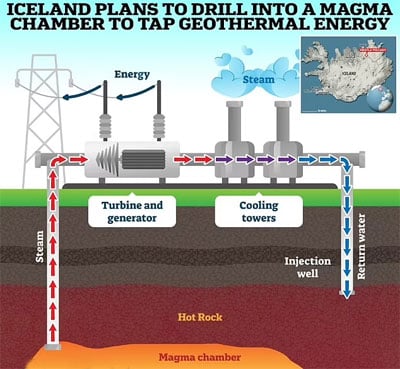

Reykjavík: The European country of Iceland is preparing to become the first country in the world to do so in scientific history by drilling into the magma chamber of a volcano.
In 2026, Iceland’s Krifla Magma Test Bed (KMT) project will excavate the magma chamber of the Krifla Volcano in the northeast of the country.
The chamber, which lies between one and a half and three kilometers below the surface, will provide unlimited geothermal energy for Iceland’s homes and buildings.
According to experts, this method is safe even though the area is very hot (temperature up to 1300 degrees Celsius) and doing so will not cause another volcanic eruption.
According to project manager Jorn Thor, this will be the first journey to reach the center of the Earth.
Iceland is already extracting geothermal energy (energy that forms deep inside the earth) to drive turbines to generate electricity.
Iceland’s geothermal power plants dig wells more than twelve kilometers deep to extract hot water vapor, which is then separated into liquid water and steam in separators.
This steam is passed through a turbine to generate electricity, but a very small amount of energy is recovered.
This geothermal energy is slightly cooler (250°C and 450°C respectively) than fossil fuel power plant steam.
According to Jon Eckelberger, a volcanologist at the University of Alaska, this steam is quite ineffective at low temperatures, so trying to create super-hot geothermal is interesting. Extracting this steam from the magma chamber at higher temperatures can produce more powerful energy.
(function(d, s, id){
var js, fjs = d.getElementsByTagName(s)[0];
if (d.getElementById(id)) {return;}
js = d.createElement(s); js.id = id;
js.src = “//connect.facebook.net/en_US/sdk.js#xfbml=1&version=v2.3&appId=770767426360150”;
fjs.parentNode.insertBefore(js, fjs);
}(document, ‘script’, ‘facebook-jssdk’));
(function(d, s, id) {
var js, fjs = d.getElementsByTagName(s)[0];
if (d.getElementById(id)) return;
js = d.createElement(s); js.id = id;
js.src = “//connect.facebook.net/en_GB/sdk.js#xfbml=1&version=v2.7”;
fjs.parentNode.insertBefore(js, fjs);
}(document, ‘script’, ‘facebook-jssdk’));



